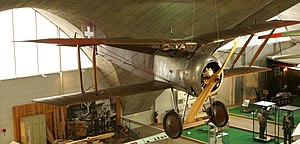Hanriot HD.1
| Hanriot HD.1 | |
|---|---|
 |
|
| Swiss HD.1 in a museum | |
| Role | Biplane fighter aircraft |
| Manufacturer | Hanriot |
| Designer | Pierre Dupont |
| Introduction | June 1916 |
| Primary users |
Corpo Aeronautico Militare Aviation Militaire Belge |
| Number built | about 1200 |
| Variants | Hanriot HD.2 |
The Hanriot HD.1 was a French World War I single-seat fighter aircraft. Rejected for service with French squadrons in favour of the SPAD S.7, the type was supplied to the Belgian and the Italian air forces with whom it proved highly successful. Of a total of about 1,200 examples built, 831 were in fact produced by Italian companies under licence.
The Hanriot company produced a series of pioneering monoplanes pre-war, but had settled down as a licence manufacturer, notably of Sopwith 1½ strutters, when the HD.1 was produced in 1916.
The type was a conventional fighter with the general characteristics of a typical Sopwith type, being strongly but lightly built, and combining clean lines with a light wing loading. In particular, it used the same “1½” (or "W") cabane strut arrangement as the Sopwith two-seater. It had a flat lower wing, though the top wing had quite sharp dihedral.
On the power of its 110 hp (82 kW) Le Rhone rotary engine it was not outstandingly fast, but it was very manoeuvrable and proved popular with pilots as a safe and pleasant aircraft to fly. To maintain a competitive climbing and altitude performance it was usual practice to restrict armament to a single synchronised Vickers gun, although there was provision for a second gun, and one was occasionally fitted. In French built aircraft the gun (or guns) were fitted to the sides of the cockpit, and were accessible to the pilot without their butts being directly in front of his face in the event of a crash – an unusual but welcome feature, even if its origins lay in the form of the cabane struts. Italian-built versions, however, mounted a single machine gun centrally.
The type was also produced by the Nieuport-Macchi company of Varese, Italy, which built almost 900 HD.1s between 1917 and 1919; more than the parent firm.
...
Wikipedia
